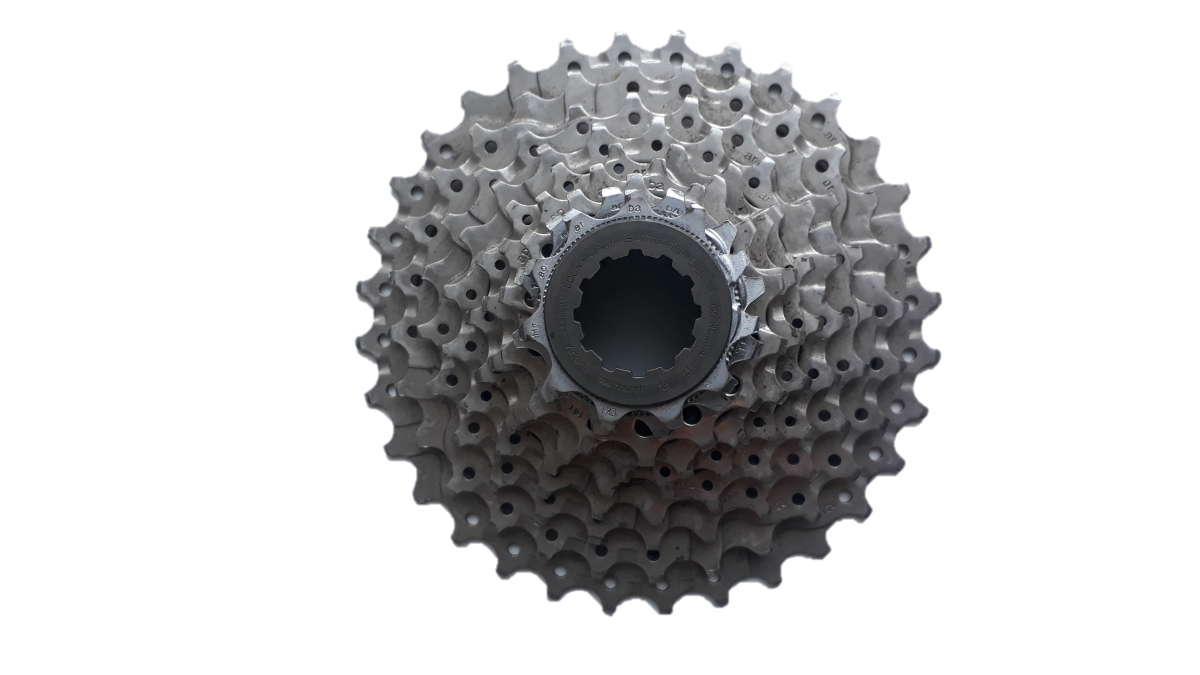What is the function of a cassette on a bicycle?
A cassette consists of several sprockets which are fixed on a freewheel, they are driven by a chain. The cassette is one of the items used to vary the gear ratio or reduction ratio of the drivetrain so that the speed of rotation of the rear wheel varies. Lower the number of teeth of the sprocket driven by the chain, greater the speed of rotation of the wheel will be. The number of gears on a bicycle is given by the number of sprockets on the cassette multiplied by the number of chainrings.Generally a cassette is made up of 5 to 12 speeds.
Characteristics
Bicycle drivetrain manufacturers such as Shimano, Campagnolo or Sram have their own standards, a Shimano cassette will not be compatible with a derailleur or Campagnolo shifters even if the number of sprockets corresponds to those of the gear levers. Indeed, the thickness of the sprockets and spacers will not be identical for a cassette 7, 8, 9, 10, 11 or 12 speed, the chain does not make the same width either. There are brands such as BBB, Sunrace,...offering cassettes and chains compatible with Shimano, Campagnolo or Sram cycling drivetrain.
MTB and road cassettes can have the same number of sprockets and come from the same brand of drivetrain but require a change of the derailleur to be compatible. In mountain bike, the wheel rotation speeds are lower than on the road. The number of teeth on the largest sprockets in the cassette of one is therefore greather than on a road bikein order to obbtain a greater torque making it possible to climb steep slopes. Derailleur manufacturers recommend a minimum and a maximum allowable number of teeth. The length of the chain tensioner of the derailleur will be greater for a MTB because of the number of teeth on the largest sprocket of the cassette.
The number of teeth of the sprockets of the cassette will depend on your level of practice and the profile of the ground that you will choose, in fact, a low gear (or drivetrain ratio) will be chosen for a steep course while a value of low gear will be chosen for a flat circuit. Bike gear ratio chart.
Methodology for bicycle cassette choice
A/ Count the number of existing cassette sprockets
B/ Identify the gears system brand and the model (derailleurs and shifters)
C/ Check the freewheel body length with the gears number of the cassette (compatibility)
D/ Check the gears number of the chain, shifters and rear derailleur (the chains 9, 10, 11 and 12s have not the same width even if it is the same brand)
E/ Identify the capacity of the rear derailleur. For example, a rear derailleur Shimano Deore RD-M615-SGS 10 speed can accept a sprocket with 32 teeth maximum and 11 teeth minimum, for a capacity of 43 teeth.
Take care the Shimano and Campagnolo groupsets are not compatibles, indeed the sprockets and washers have not the same tickness. But a Sram cassette will be compatible with Shimano groupset.
If you want to replace a used cassette by a new one, you will have to replace the chain also, because after thousand kilometers the chain stretches. With a used cassette, you have to use a used chain.
For a cassette replacement by a new one with smaller sprockets you will have to reduce the length of the chain. If the sprockets are higher, the chain length will be longer.
It will be possible to use a "road" cassette on a mtb and conversely if the derailleur capacity can do it.
Maintenance
For optimal operation and a long service life, it is necessary to regularly clean (the ideal is after each ride) the cassette to remove polluants (dust, sand, ...) as well as the dried grease using a degreaser and lubricate it again with a suitable product (which does not retain dust and earth particles). Here are some examples of degreasers and lubricants.
